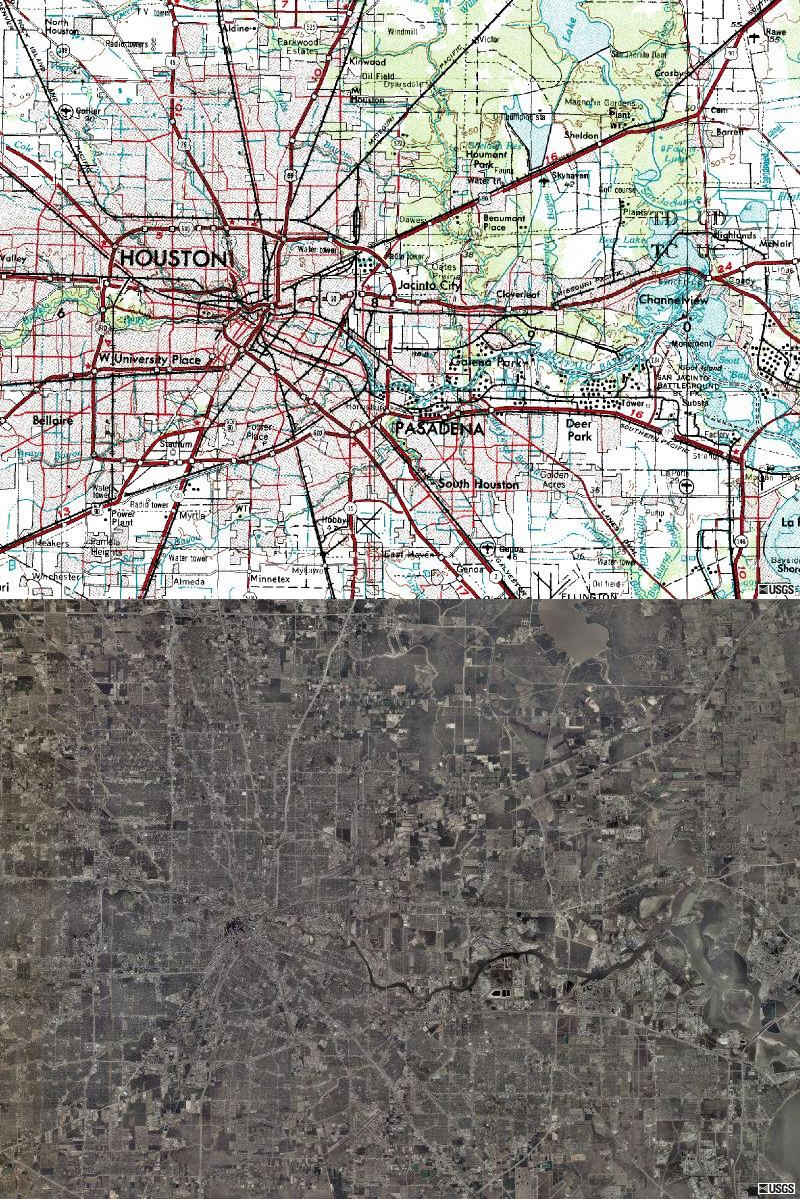Eyeballing
the
Houston Ship Channel

2 June 2004. One of the Eyeball series.
Source of maps and photos: http://www.terraserver-usa.com
Terraserver USA is now offering 0.25-meter resolution color images of selected urban areas photographed in 2001 and 2002. These appear to be versions of the 1-foot, high-resolution images available at http://seamless.usgs.gov. For the list of urban areas see: http://seamless.usgs.gov/news.html
__________
Port of Houston Authority: http://www.portofhouston.com/
The Port of Houston is a 25-mile-long complex of diversified public and private facilities located just a few hours' sailing time from the Gulf of Mexico. The port is ranked first in the United States in foreign waterborne commerce, second in total tonnage, and sixth in the world.The Port of Houston is made up of the port authority and the 150-plus private industrial companies along the ship channel. All together, the port authority and its neighbors along the Houston Ship Channel are a large and vibrant component to our regional economy.
Approximately 175 million tons of cargo moved through the Port of Houston in 2002. A total of 6,414 vessel calls were recorded at the Port of Houston during the year 2002.
The Port of Houston Authority owns and operates the public facilities located on the Houston Ship Channel and is the ship channel's official sponsor. These facilities were designed for handling general cargo, containers, grain and other dry bulk materials, project and heavy-lift cargo and virtually any other kind of cargo.
Public facilities which are owned and operated by the Port Authority include 43 general cargo wharves available for public hire and two liquid-cargo wharves. The Port Authority's facilities handle approximately 15 percent of the cargo moving through the Port.
These existing facilities offer shippers deep water access to world markets and a direct link to 14,000 miles (22,400 kilometers/12,180 nautical miles) of U.S. intracoastal and navigable inland waterways. A vast network of interstate highways and rail connections link Houston with inland markets; two major railroads and approximately 150 trucking lines connect the Port to the continental United States, Canada and Mexico. Air service is also easily accessible through two major public airports, Bush Intercontinental and Hobby, and dozens of private terminals.
http://www.nytimes.com/2004/05/28/business/28disrupt.html
If Oil Supplies Were Disrupted, Then ...By SIMON ROMERO
"A possible attack is absolutely a concern for us," said a spokesman for a group that represents 125 industrial concerns, including refineries and petrochemical plants, along the Houston Ship Channel.
Associated Press
Published: May 28, 2004
[Excerpts]
HOUSTON, May 27 - With demand high, supplies squeezed, prices climbing and refineries already running flat out, what if something really went wrong? Something like a terror attack on crucial oil installations in Saudi Arabia or in the United States, or something less sinister but just as disruptive, like a fire or accident at a major refinery or port or a flare-up of civil or labor turmoil in Nigeria or Venezuela?
Industry experts say that the drum-tight American fuel market has become unusually vulnerable to any such nasty surprises, because there is little spare capacity available and because traders, executives and policy makers are nervous about terrorism and other threats - to the point that crude oil now carries a "risk premium" of 12 to 25 percent, analysts estimate.
"The problem is, we've already tasted some of these events in one form or another," said Daniel Yergin, chairman of Cambridge Energy Research Associates, an energy analysis company. "The threat of an oil shock is very tangible. If an oil trader wants to think about risk, all he has to do is turn on the television."
To be sure, there are important differences between conditions today and 30 years ago, when tensions in the Middle East disrupted oil supplies. Few economists see much danger of the rationing, gas lines, sharp inflation and deep recession of those years recurring today. Energy is a smaller component of the overall economy now, prices are still fairly low in inflation-adjusted terms, and measures taken after the oil shocks of the 1970's provide some protection, most notably the creation of the Strategic Petroleum Reserve, with a capacity of 700 million barrels.
Even so, President Bush's decision to fill the reserve after the terror attacks of September 2001 has been one of the factors driving up oil prices in recent months, along with reports that China, which recently surpassed Japan as the second-largest importer of oil, is going ahead with plans to build its own petroleum reserve. The Bush administration has resisted calls to release oil from the American reserve.
The reserve now holds about 660 million barrels, making it the world's largest source of stockpiled petroleum. Other domestic stocks, held commercially in refineries, pipelines or storage tanks, stand at about 299 million barrels, about 5 percent below the average level of the last five years, according to the Energy Information Administration.
Along with security concerns abroad, the fear of attacks on energy hubs within the United States also haunts the market. While there is little public evidence that such attacks are being planned, the F.B.I. issued a warning in March that Al Qaeda might be preparing to blow up pipelines and refineries in Texas ahead of the November elections.
The Houston area, with two of the four largest oil refineries in the United States and much of the infrastructure used to transport oil and natural gas around the country, has been mentioned as the most sensitive potential target. The city is also the intellectual and financial center for the global energy industry.
"A possible attack is absolutely a concern for us," said Rick Hagar, spokesman for the East Harris County Manufacturers Association, which represents 125 industrial concerns along the Houston Ship Channel, among them refineries, shipping companies and petrochemical plants. "It's something to worry about night and day."
|
| 64-meter resolution.
|
| 16-meter resolution.
|
| 4-meter resolution.
|